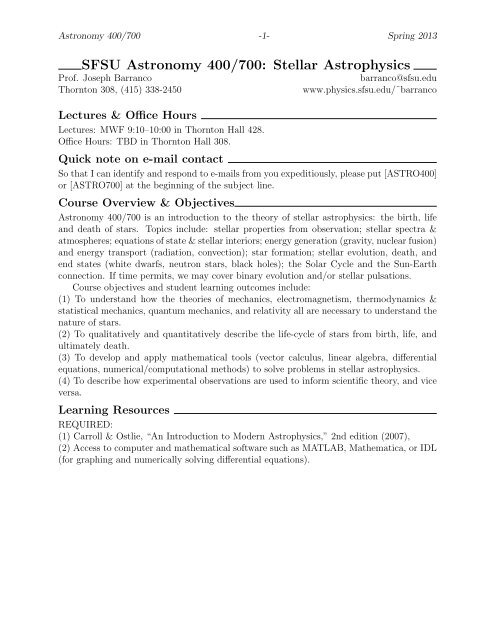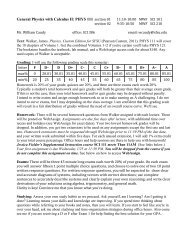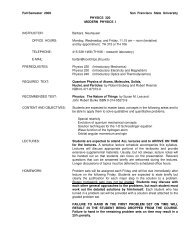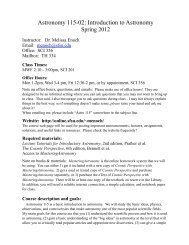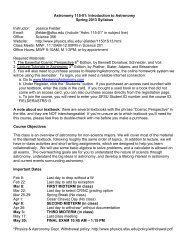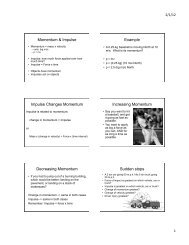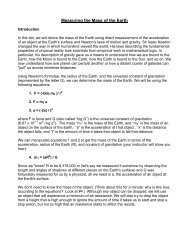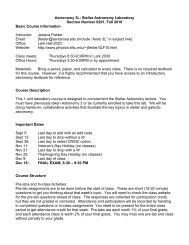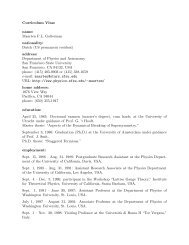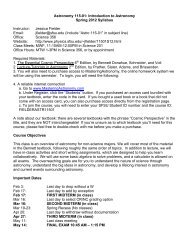Syllabus for Astronomy 400/700 (PDF) - SFSU Physics & Astronomy ...
Syllabus for Astronomy 400/700 (PDF) - SFSU Physics & Astronomy ...
Syllabus for Astronomy 400/700 (PDF) - SFSU Physics & Astronomy ...
You also want an ePaper? Increase the reach of your titles
YUMPU automatically turns print PDFs into web optimized ePapers that Google loves.
<strong>Astronomy</strong> <strong>400</strong>/<strong>700</strong> -1- Spring 2013<br />
<strong>SFSU</strong> <strong>Astronomy</strong> <strong>400</strong>/<strong>700</strong>: Stellar Astrophysics<br />
Prof. Joseph Barranco<br />
Thornton 308, (415) 338-2450<br />
Lectures & Office Hours<br />
Lectures: MWF 9:10–10:00 in Thornton Hall 428.<br />
Office Hours: TBD in Thornton Hall 308.<br />
barranco@sfsu.edu<br />
www.physics.sfsu.edu/˜barranco<br />
Quick note on e-mail contact<br />
So that I can identify and respond to e-mails from you expeditiously, please put [ASTRO<strong>400</strong>]<br />
or [ASTRO<strong>700</strong>] at the beginning of the subject line.<br />
Course Overview & Objectives<br />
<strong>Astronomy</strong> <strong>400</strong>/<strong>700</strong> is an introduction to the theory of stellar astrophysics: the birth, life<br />
and death of stars. Topics include: stellar properties from observation; stellar spectra &<br />
atmospheres; equations of state & stellar interiors; energy generation (gravity, nuclear fusion)<br />
and energy transport (radiation, convection); star <strong>for</strong>mation; stellar evolution, death, and<br />
end states (white dwarfs, neutron stars, black holes); the Solar Cycle and the Sun-Earth<br />
connection. If time permits, we may cover binary evolution and/or stellar pulsations.<br />
Course objectives and student learning outcomes include:<br />
(1) To understand how the theories of mechanics, electromagnetism, thermodynamics &<br />
statistical mechanics, quantum mechanics, and relativity all are necessary to understand the<br />
nature of stars.<br />
(2) To qualitatively and quantitatively describe the life-cycle of stars from birth, life, and<br />
ultimately death.<br />
(3) To develop and apply mathematical tools (vector calculus, linear algebra, differential<br />
equations, numerical/computational methods) to solve problems in stellar astrophysics.<br />
(4) To describe how experimental observations are used to in<strong>for</strong>m scientific theory, and vice<br />
versa.<br />
Learning Resources<br />
REQUIRED:<br />
(1) Carroll & Ostlie, “An Introduction to Modern Astrophysics,” 2nd edition (2007),<br />
(2) Access to computer and mathematical software such as MATLAB, Mathematica, or IDL<br />
(<strong>for</strong> graphing and numerically solving differential equations).
<strong>Astronomy</strong> <strong>400</strong>/<strong>700</strong> -2- Spring 2013<br />
Useful Websites<br />
(1) www.physics.sfsu.edu – Department of <strong>Physics</strong> & <strong>Astronomy</strong><br />
(2) ilearn.sfsu.edu (note: no www in web address) – Login to access course website. Please<br />
check frequently <strong>for</strong> new announcements, updates to the syllabus & schedule, tips & tricks<br />
on the homework, and links to additional learning resources.<br />
(3) http://www.pas.rochester.edu/˜emamajek/sun.txt – The most up-to-date experimental<br />
data <strong>for</strong> the Sun.<br />
(4) http://www.astro.wisc.edu/˜dolan/constants/calc.html – Astro-physical calculator: an<br />
online calculator with buttons <strong>for</strong> fundamental constants and astronomical data<br />
(5) http://mathworld.wolfram.com/ – Wolfram Mathworld<br />
(6) http://scienceworld.wolfram.com/physics/ – Wolfram World of <strong>Physics</strong><br />
Recommended Preparation<br />
(1) <strong>Physics</strong> 320 (Modern <strong>Physics</strong> I)<br />
(2) <strong>Physics</strong> 330 (Analytic Mechanics I)<br />
(3) <strong>Physics</strong> 385 (Introduction to Theoretical <strong>Physics</strong> I)<br />
(4) Computer Science 309 (Computer Programming <strong>for</strong> Scientists & Engineers)<br />
Please see me if you have any concerns about your preparation.<br />
Assignment of Grades<br />
Grades will be determined by your per<strong>for</strong>mance on homework (40%), 2 midterm exams<br />
(10% each), an in-class oral presentation (10%), and a final exam (30%). Note that students<br />
enrolled in the graduate version of this course will have additional reading and longer, more<br />
challenging homework assignments. The midterm and final exam will also have take-home<br />
components <strong>for</strong> graduate students.<br />
Letter grades will assigned according to the following scheme:<br />
A: 90.0% – 100.0% A-: 85.0% – 89.9%<br />
B+: 80.0% – 84.9% B: 75.0% – 79.9% B-: 70.0% – 74.9%<br />
C+: 65.0% – 69.9% C: 60.0% – 64.9% C-: 55.0% – 59.9%<br />
D+: 50.0% – 54.9% D: 45.0% – 49.9% D-: 40.0% – 44.9%<br />
Homework<br />
You cannot learn physics solely from lectures. You must work through many problems,<br />
seeing how the theoretical concepts discussed in lecture apply in various different contexts.<br />
Homework is an integral part of the learning process; how serious you take the homework<br />
will ultimately determine how much you will understand physics and how well you will do<br />
in the course overall. There will be approximately one homework assignment due per week.<br />
Most problems will require analytic solutions, however there will usually be one problem per<br />
assignment that will involve graphing and numerical solution with computer software such<br />
as Microsoft Excel, MATLAB, or Mathematica.
<strong>Astronomy</strong> <strong>400</strong>/<strong>700</strong> -3- Spring 2013<br />
Policy on Collaboration & Academic Integrity<br />
You are strongly encouraged to discuss course material with your fellow classmates. When<br />
working on homework, first try to solve the problems on your own. Struggle. Struggle<br />
some more. If you get stuck, feel free to discuss overall methods and approaches with your<br />
classmates, but not the details! Your written solutions should be solely your own, and<br />
should be written-up in isolation from your fellow classmates. Copying is strictly prohibited.<br />
Cheating via any method on exams will result in a grade of zero on that exam and<br />
being reported to the department chair and college dean <strong>for</strong> possible discipline. Please<br />
see the official academic integrity policy <strong>for</strong> the Department of <strong>Physics</strong> & <strong>Astronomy</strong> at:<br />
www.physics.sfsu.edu/policy/plagiarism.pdf.<br />
Drop, Withdrawal & Repeat Policy<br />
The “Drop” deadline is Friday, February 8. You can drop yourself online without any penalty<br />
and without any record, <strong>for</strong> any reason. After February 8, students must petition <strong>for</strong> an<br />
official “withdrawal.” Documents must be provided to support the petition to withdraw. If<br />
the petition is approved, the designation “W” will appear on the transcript. Students are<br />
only allowed to repeat a class once at <strong>SFSU</strong>. Note that designations of W, WU, NC count<br />
toward this limit.<br />
Expected Code of Conduct<br />
Classroom discussion and participation are strongly encouraged. However, please refrain<br />
from unrelated chatter. Also, please remember to place cell phones and other electronic<br />
communication devices on silent or vibration mode so as not to distract your fellow classmates.<br />
If you must arrive late or leave early, please sit toward the back of the room near the<br />
doors so as to minimize disruption.<br />
Disability Access<br />
Students with disabilities who need reasonable accommodations are encouraged to contact<br />
me early in the semester. The Disability Programs and Resource Center is available to<br />
facilitate the reasonable accommodations process. The DPRC, located in Student Services<br />
Building 110, can be reached by phone at 415-338-2472 (voice/TTY) or by e-mail<br />
at dprc@sfsu.edu.<br />
Religious Holidays<br />
The faculty of San Francisco State University shall accommodate students wishing to observe<br />
religious holidays when such observances require students to be absent from class activities.<br />
It is the responsibility of the student to in<strong>for</strong>m the instructor, in writing, about such holidays<br />
during the first two weeks of the class each semester. It is the responsibility of the instructor<br />
to make every reasonable ef<strong>for</strong>t to honor the student request without penalty, and of the<br />
student to make up the work missed.
<strong>Astronomy</strong> <strong>400</strong>/<strong>700</strong> -4- Spring 2013<br />
Preliminary Schedule (Subject to change!)<br />
Jan. 28 - Feb. 1 course introduction; radiation concepts<br />
Feb. 4-8 stellar spectra and stellar atmospheres<br />
Feb. 11-15 Hertzsprung-Russell diagram; binary stars<br />
Feb. 18-22 hydrostatic balance and equations of state<br />
Feb. 28 - Mar. 1 energy transport<br />
Mar. 4-8 energy transport<br />
Mar. 11-15 nuclear processes<br />
Mar. 18-22 nuclear processes<br />
Mar. 25-29 SPRING BREAK<br />
Apr. 1-5 stellar evolution: low mass stars<br />
Apr. 8-12 stellar evolution: high mass stars<br />
Apr. 15-19 stellar death<br />
Apr. 22-26 stellar death<br />
Apr. 29 - May 3 star & planet <strong>for</strong>mation<br />
May 6-10 interacting binaries<br />
May 13-17 oral presentations<br />
May 22 Final Exam, 8:00 – 10:30<br />
Suggested Topics <strong>for</strong> Oral Presentation<br />
• stellar pulsations & astroseismology<br />
• solar neutrino problem and its resolution<br />
• sunspots and the solar cycle<br />
• solar flares, coronal mass ejections<br />
• interaction of solar wind and planetary magnetospheres<br />
• star <strong>for</strong>mation and the Initial Mass Function (IMF)<br />
• brown dwarf, white dwarf, and/or neutron star cooling<br />
• brown dwarf atmospheres and weather<br />
• brown dwarf demographics and <strong>for</strong>mation<br />
• rotation of neutron stars/pulsars<br />
• differential stellar rotation and the Rossiter-McLaughlin effect<br />
• red giant evolution, winds & planetary nebulae<br />
• supernovae spectra and light curves<br />
• magnetic fields and star <strong>for</strong>mation<br />
• detection of exoplanets; the planet-stellar metallicity correlation<br />
• T-Tauri stars & protoplanetary disks: theory or observation<br />
• blue stragglers<br />
• binaries in globular clusters<br />
• interacting binaries, cataclysmic variables, novae<br />
• using stars to measure distances in the universe<br />
• gamma ray bursts<br />
• mergers of neutron stars and/or black holes<br />
• solar corona and magnetic reconnection<br />
• metallicity gradients in the Milky Way Galaxy<br />
• high velocity stars and ejection of stars from the galaxy<br />
• astrometry in the center of the galaxy to constrain the central black hole<br />
• archeoastronomy and the use of stars in calendars, navigation


